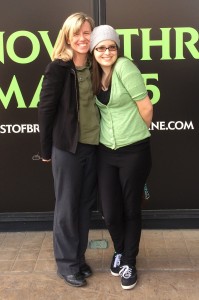
Tessa Senger, of Spokane, Wash., appeared to be a perfectly healthy child until she began having seizures at age 4. Her mother, Brenda Senger, took Tessa to a local neurologist, who diagnosed her with epilepsy. But the treatments prescribed to Tessa did not lessen her seizures, which were occurring up to 50 times each day. Tessa grew weaker and began losing weight.
“I felt helpless,” her mom said. “I just wanted her seizures to stop and for her to start growing again.”
Eventually, Tessa was referred to Seattle Children’s Hospital, where Dr. Russell Saneto, director of the Mitochondrial Medicine and Metabolism Care Team at Seattle Children’s and an investigator at Seattle Children’s Research Institute’s Center for Developmental Therapeutics, diagnosed her with a mitochondrial disease. Saneto prescribed a vitamin cocktail and seizure medications that changed Tessa’s life. The tiny girl, who weighed just 35 pounds until age 6, finally started gaining weight and her seizures stopped almost completely. Tessa is now 15 years old and has only had two seizures since second grade. She is healthy enough to begin reducing her seizure medications.
“Tessa is just thriving year after year,” Senger said. “I am thankful every day that we found Dr. Saneto and the support of Seattle Children’s Hospital.”
What is mitochondrial disease?
Mitochondrial disease is a potentially life-threatening group of disorders in which cells fail to generate the energy the body needs to live and grow. Between 1 in 5000 children are born with a mitochondrial disease in the United States every year.
These diseases cause the most damage to cells of the brain, heart, liver, skeletal muscles, kidney and the endocrine and respiratory systems. Depending on which cells are affected, symptoms may include loss of motor control, muscle weakness and pain, gastro-intestinal disorders and swallowing difficulties, poor growth, cardiac disease, liver disease, diabetes, respiratory complications, seizures, visual or hearing problems, lactic acidosis, developmental delays and susceptibility to infection.
Difficult to diagnose, harder to treat
Mitochondrial disease is often misdiagnosed because the symptoms vary significantly between patients and can easily be mistaken for other diseases. There is no cure for mitochondrial disease and patients don’t always find an effective treatment like Tessa did.
Dr. Philip Morgan, an anesthesiologist on the Mitochondrial Medicine and Metabolism Care Team and investigator in the Center for Developmental Therapeutics, explained that while mitochondrial diseases are caused by defects in the proteins of the mitochondria, there are over 1000 different proteins in a functioning mitochondria.
“With so many different causes, there are also many different types of mitochondrial disease,” Morgan said. “We expect the many variations of this disease will require a variety of treatments as well.”
Still, researchers are looking for ways to bring energy back to cells that have been “shut down” by mitochondrial disease. They are currently testing potential treatments in animal models. Morgan’s research has already impacted his clinical work as an anesthesiologist. He is currently working with Dr. Margaret Sedensky to study the wide differences in the way patients with mitochondrial diseases respond to anesthesia to improve patients’ perioperative experience.
“While a cure is still several years away, research studies that provide a better understanding of this extremely complex disease will hopefully result in new medical treatments that will improve the quality of life for children living with the impacts of this disease,” Morgan said.
Philanthropy in action
Morgan’s and Sedensky’s research has been supported in part by generous philanthropy of the Northwest Mitochondrial Research Guild. Jill Herczog, the mother of two daughters with mitochondrial disease, co-founded the guild in 2003 to raise awareness, improve care and spur research after struggling to find answers for her daughters.Over the last nine years, the Mitochondrial Research Guild has raised over $1.8 million to support clinicians and researchers in the Program for Mitochondrial Medicine and Metabolism at Seattle Children’s.
To educate families on the latest treatment options for mitochondrial diseases, Seattle Children’s Research Institute, in collaboration with the Mitochondrial Research Guild, will host the 2014 Mitochondrial Biology Conference on Sept. 12 and 13. The conference will bring together renowned leaders in the field of mitochondrial disease research and patient care. Families and patients are welcome to attend and join in discussion of newly recognized atypical presentations of mitochondrial diseases and new treatment options. To attend the Mitochondrial Biology Conference register online or call (206) 987-5379 before Sept. 5, 2014.
Resources:

